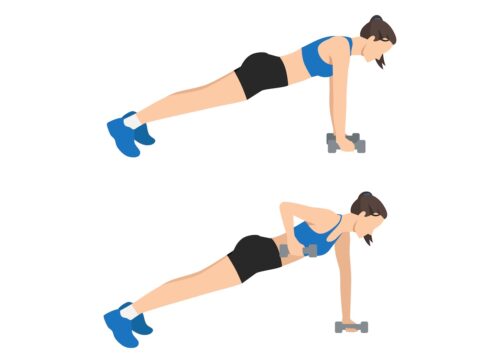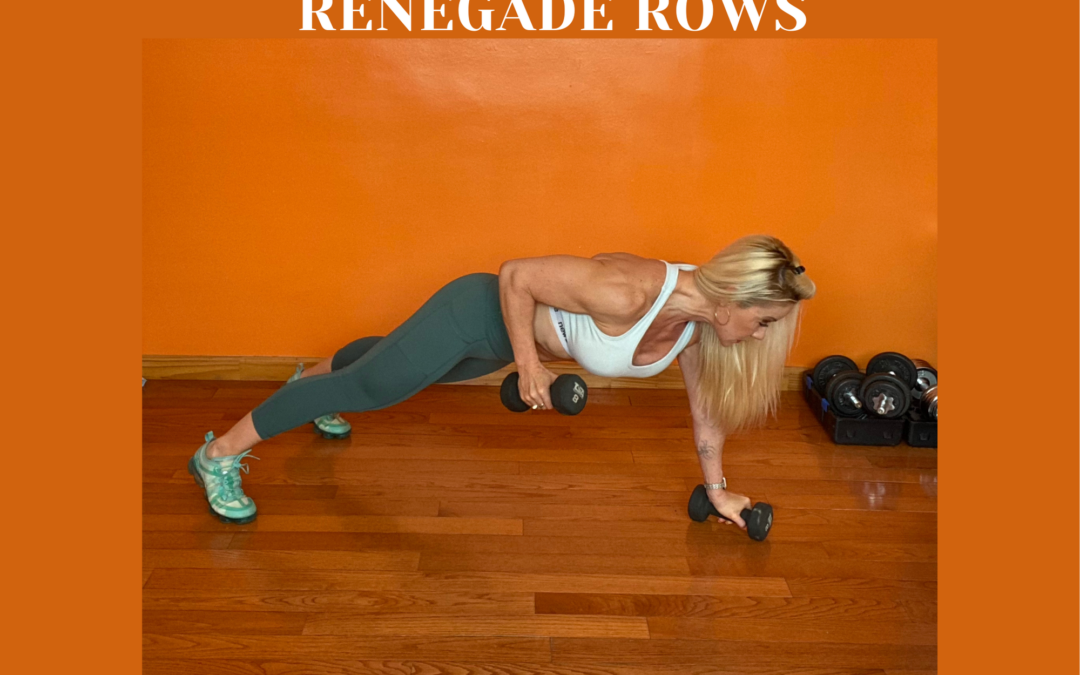Back pain and bad posture are common problems in our society. One of the causes of these two issues is weak back and core muscles. The renegade row is a wonderful exercise that not only targets the muscles used in a traditional row, the back muscles, but also works numerous muscles throughout your whole body. And the best part is that you only need a set of dumbbells!
Below we’ll cover everything you need to know about renegade rows:
- Muscles involved in renegade rows
- Benefits associated with renegade rows
- How to properly do renegade rows
- Common mistakes when performing renegade rows
- Video showing how to do renegade rows
- Exercises to complete your workout
What Muscles Do Renegade Rows Work?
The renegade row is a compound exercise that works multiple joints at the same time:
Primary Muscles
- Latissimus dorsi: This is the largest muscle in the back that starts under the tail end of the trapezius and goes all the way down to the sacrum, and out onto the posterior iliac crest. It also has some fibers arising from the lower four ribs, and occasionally from the tip of the scapula. The lats are powerful adductors of the humerus and depressors of the scapula
- Serratus: These muscles arise by the vertebra and move toward the ribs. Posterior upper serratus muscles are situated at the upper back part of the thorax, deep to the rhomboid muscles. They elevate the ribs and aid deep respiration. Posterior lower serratus muscles are situated at the lumbar region and draw the lower ribs backward and downward, assisting in the rotation and extension of the trunk. Serratus anterior muscles arise from the side and front of the first eight ribs and run back under the scapula. They move the scapula and aid in respiration.
- Rhomboids: Muscles located in the upper back in between the scapula. They support and draw the scapula superomedially, and rotate the glenoid cavity
- Core Muscles: These include the abdominal muscles (rectus abdominis -referred to as the six-pack, transverse abdominal, the external and internal obliques, and pyramidalis), as well as the pelvic floor muscles, erector spinae, and lumbar muscles.
Secondary Muscles
- Anterior Deltoids: These muscles are located in the front of the shoulders. They assist the pecs to flex the shoulder, as well as the subscapularis and lats to internally rotate the humerus.
- Biceps (biceps brachii): These muscles are on the front of the arms. They are involved in forearm and elbow movement, shoulder flexion, as well as arm abduction, and adduction.
- Forearms: Located in the upper limbs between the elbows and the wrists. There are several muscles part of this area. They help pronate, flex, abduct, and adduct the hands.
- Triceps Brachii: These muscles are located in the back of the arms. The triceps are involved in forearm and elbow extension, helping extend or straighten the elbow. They are also involved in shoulder adduction and extension, helping pull the arms down. Additionally, they help to stabilize the shoulder joint.
Benefits of Renegade Rows
- Fat Burning: Renegade rows help burn tons of calories due to engaging multiple muscles simultaneously.
- Endurance: Being in a plank position keeps your muscles under tension, enabling longer muscle endurance.
- Better Posture: Renegade rows strengthen your back and core which helps keep your spine in alignment and improve your posture. This helps prevent injuries and gives you a more confident look.
- Less Back Pain: They keep your back healthy and your core strong, helping prevent and deal with back pain.
- Increased Focus: This exercise entails holding your weight for a certain amount of time while lifting weights, which helps improve your ability to focus under tension.
- Versatility: Renegade rows only require a set of dumbbells, making them highly versatile and allowing you to work out anytime and anywhere.
- Unilateral Strength and Balance: They are unilaterally challenging – one arm lifts a weight off the floor while the other supports the body. This increases multi-muscle activation and strength while avoiding imbalances.
- Hypertrophy: Renegade rows help you grow your back and arm muscles.
How to Do Renegade Rows

- Grab two dumbbells and put them on the floor at each side of your body by your arms. Get into a pushup position with your body in a straight line without dropping or raising your hips. Keep your chin tucked throughout the movement and your feet slightly wider than your hips for greater stability.
- While maintaining proper posture, grab your dumbbells one hand at a time. Proceed to get one dumbbell toward the ceiling by using your lat and bending your elbow. Your elbow should be 30–45 degrees away from your body. Your shoulder blades should retract as you pull the dumbbell toward your hip. Your upper arm should be in line with your body with a neutral wrist. Your hips and shoulders should be squared toward the floor.
- Pause for a second or two at the top of the movement.
- Slowly bring the dumbbell down to the starting position.
- Repeat the upward movement on the opposite side.
- One full repetition is completed once you perform a rowing move on each side.
- Perform 3 sets of 8-12 repetitions.
Renegade Rows Mistakes
Now you know how to perform renegade rows with the correct form. Next, let’s look into the most common mistakes associated with the exercise:
- Arching Your Lower Back: You should maintain a neutral spine. Arching your lower back excessively can lead to low back injury or pain. It can be indicative of poor core stability. If you don’t seem able to perform renegade rows with a neutral spine, try them on your knees or widen your legs more.
- Rotating Your Torso: Movement comes from your arms, not your upper body. This is not a rotation exercise. If you are rotating your torso to perform this exercise, you are taking the emphasis off your back and arms.
- Short Range of Motion: You use a short range of motion when you lift the weights off the floor only a little bit. You are supposed to bring the weights up all the way toward your underarm. If you can’t do so, you should use lighter weights.
- Not keeping your hips in a straight line with your body: Your hips should remain parallel to the floor. You shouldn’t move them upwards or drop them down toward the floor. This may indicate that you lack core stability and strength. You should try widening your feet and/or decreasing the weight.
- Not engaging the back: As you bring the weight up, you should squeeze your shoulder blades together in order to engage your back – not just pull your arms up.
Renegade Row Video Tutorial
Exercises for a Full-Body Workout
You can complete your full-body workout by performing the following exercises:
- Bent Over Underhand Barbell Rows
- Dumbbell Overhead Lunge
- Reverse Crunches
- Hamstring Walkouts
- Side-to-Side Pushup
As you can see the renegade row is a wonderful full-body exercise. It offers tremendous benefits associated with hypertrophy, strength, endurance, agility, and aesthetics. Now that you know how to properly perform reverse lat pulldowns, you can avoid the most common mistakes and enjoy their benefits. Remember, whether you want to lose weight, tone your body, or gain strength or size, all muscles must be trained.
Lift, Burn more Fat, Get Stronger, and Live Healthier!
To a Fitter Healthier You,
The Fitness Wellness Mentor



